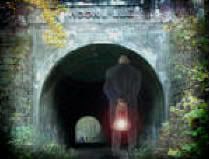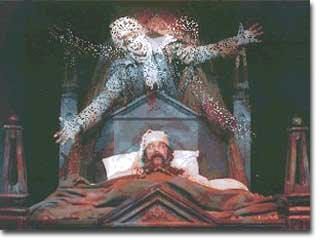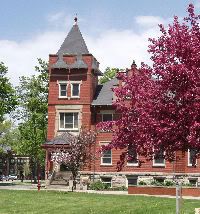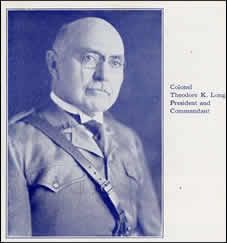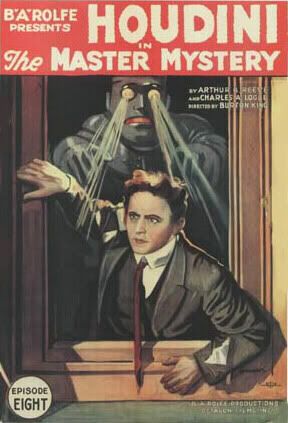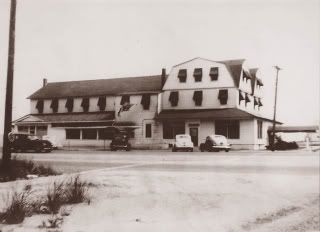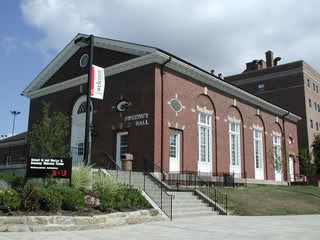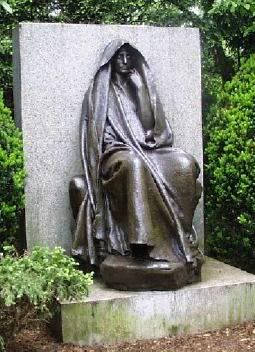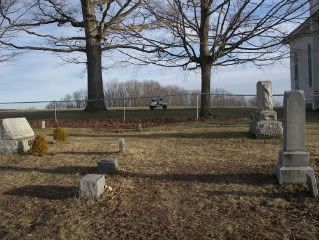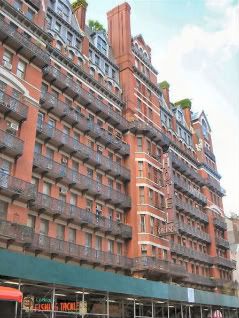
Hotel Chelsea from Wikipedia CommonsThe sun's out, the top's down, the wind's blowing in our hair, and we're cruising catty-corner across Ohio, Pennsylvania and the Empire State. We're heading for the Big Apple.
H&H is ready to gawk. We're hot to see Ellis Island, to find out if any of our forebears are haunting the portal to the Promised Land. But first, we need a place to crash.
The old
Brittany Hotel on East Tenth Street looks like a fine place to park our bags. Built in 1929, it's right by the spook-laden Washington Square Park and has all the amenities we're looking for in a rent-a-room. It's penthouse was once a speakeasy, and its guests included Walter Winchell, Jerry Garcia, and Al Pacino.
What? It's a New York University dorm now? Will my 1971 Pitt ID get me a spot to flop? OK, OK, quit pushin', I'm going.
Just as well, we suppose. Old hotel regulars and the dorm residents have reported hearing mysterious music, bodiless footsteps, and the sense of being watched. The basement is supposed to be an especially eerie maze, and the penthouse is said to host a noisy, never-ending ghost gala. Party on, phantom dudes!
One roomie even reported being transported at warp speed by a house spook through the Brittany electrical system in a dream and deposited in his room's smoke detector - which woke him up when it went off. So that's how they get around!
Well, we'll just get a room in the stately
Grosvenor Hotel on Fifth Avenue, opened in 1925. Dang! NYU bought up this grand old dame in 1964, made it a dorm and named it Rubin Hall. Where's a man to lay his head? Do we have to enroll at NYU to get a bed in the City that never sleeps?
Hmmm...on second thought, we might not get a good night's rest there, either. It seems the shades of former Grosvenor boarders have taken up in one of the dorm's rooms. According to rumors among Rubin students and staff, an older couple, who were the last two people to leave the building after the University bought it, have returned to reclaim their familiar former digs in the afterlife.
In another case, after learning from a Rubin RA that her room, #903, was haunted, a NYU student used her Ouija board to contact the ghost. During their chat, she discovered that the spook's name was Al and believes he was a bootlegger in the 1930s. Now that they're on a first-name basis, he doesn't lock her in the bathroom anymore. Spirits are such comedians!
One alleged ghostie there has been debunked, though. Samuel Clemens (you may know him as Mark Twain), who according to local lore does haunt the halls of the old Breevort apartments (the "Death House") down the street, doesn't hang out in the Grosvenor. He was supposed to have lived there, but since he died 15 years before it was built...
Maybe the
Hotel des Artistes on 67th Street in Central Park West will have a vacancy. Oooops, just looked at the rates...H&H will be moving on. But first, a stop in its cafe for a cold one before we continue our search.
There we hear about the bar's famous spook. The help is mum, but the regulars tell of a cloudlike apparition that reaches out and touches the paying customers as it goes by. No one is really sure who the downstairs drinking hole shadow is, but the list of suspects is pretty impressive - Marcel Duchamp, Isadora Duncan, and Fiorella LaGuardia are just a few of the names under the scope.
Off we trudge to Manhattan, and the artsy
Algonquin Hotel. It opened for business in 1902 and was an instant drawing card for the literary set. Across the street from the Ziegfield Folly foxes, it was also close at hand to famed eateries like Delmonico's and crowd magnets Times Square and the Great White Way.
It drew all kinds of big-time literati and actors, but its most famous crew was the acid-tongued wits of the Round Table (aka, the "Vicious Circle"), who met for lunch every day and after the shows at the Algonquin during the 1920s. Among them were Dorothy Parker, Harpo Marx, Heywood Broun, George Kaufman and Edna Ferber, part of a cast of dozens eager to puncture whatever show biz balloon that happened to float by.
Besides injuring the pride of countless performers, they continue to scare the pants off of innocent hotel guests. Some of the visitors claimed to have seen the ghosts of the Round Table's members lurking around the hotel halls and bar, the Oak Room, where patrons have reportedly channeled some of their famous quips. Ah, the power of spectral suggestion.
The historic Algonquin was renovated in 2004, and the updates seemed to have displeased the hotel's resident spirits. Eerie noises emanated from a 13th floor room on the night the work was completed (a hotel with a 13th floor? It deserves to be haunted!) At 3 AM, a picture of Dorothy Parker fell off the wall and shattered. Maybe her shade was a bit tipsy at that hour.
The resident cat, Matilda, is apparently well-acquainted with the sarcastic spooks.
"The cat seems to know things the rest of us don't know," Barbara McGurn, hotel historian, told
Fox News in 2005. "She could be looking at people she sees whom we can't. I think she tries to make peace among the various ghosts of characters who stayed here and lived here and partied here."
The Algonquin ghost tale is so much a part of the hotel's history that every New Year's Eve, at the stroke of midnight, the kitchen staff marches around the building banging pots and pans in an effort to chase the building's apparitions to a quieter locale. It hasn't worked, so far.
As is our wont, we stopped for a beverage before inquiring about a room. The room was nice, the crowd friendly, and the bar tab for a C.C. and soda was $15. We continued on our search. We wonder if NYC has any hostels?
Hey, there's another joint. We'll try our luck here, at the
Hotel Chelsea on West 23rd Street. It was built in 1883 as an early co-op, and it sports a guest list of cutting edge artists a mile long.
In fact, Leonard Cohen penned a song about it, "Chelsea Hotel," and Andy Warhol was inspired by its muse when he filmed "Chelsea Girl." There are at least 50 references to the Hotel Chelsea in films, songs, and books, according to
Wikipedia.
As Janis Joplin said: "A lot of funky things happen at the Chelsea." Maybe she was alluding to actress Sarah Bernhardt, who used to sleep in a coffin when she lived there. But most of the funkiness can be attributed to its cast of artists who checked in, but never checked out of their NYC home. It's said that half of its rooms host a spectral presence.
John Ritchie, better known as Sid Vicious of the Sex Pistols, may or may not have knifed his lady in Room #100 of the hotel in 1978, but he's stayed on. It's said that you can share a ride with him occasionally on the building elevator, even though he died of a heroin OD in 1979.
Welsh poet Dylan Thomas spent his final days on the planet in an alcoholic daze. He died in the hotel after drinking himself into a stupor at the nearby White Horse Tavern and being carried back to the crib by his bar room buds. Local lore claims that his soused specter haunts both spots now.
The spooks of writers Eugene O'Neill and Thomas Wolfe have also been reported as loitering in the Algonquin. Its bar, the Star Lounge, has troubles with its electrical system, noises clattering from its back room, and lights that flicker on and off that it blames on the paranormal. And, according to a visiting psychic, it has it's own spook, an unhappy older lady that left life but couldn't bear to part with her lounge lizard friends partying downstairs.
Maybe we'll pass on this place, too. Looks like we'll spend the night curled up in the back seat of the ol' clunker. We don't think there are any spooks there, except maybe for the ghost of a Primanti Brother's sandwich.
The
Ellis Island expedition? Nary a spirit to be found. Just the residual phenomena of children's laughter and crying, voices, and footsteps are all that's reported from those hallowed halls. It seems like everyone was in such a hurry to get on with their new life that they all moved on, body and soul.
Too bad. I really would have liked to have one more chat with grandpap Rocco.
